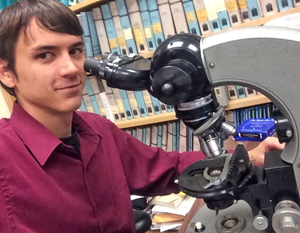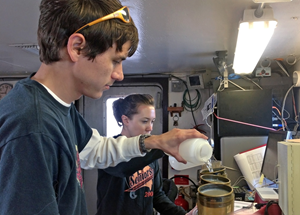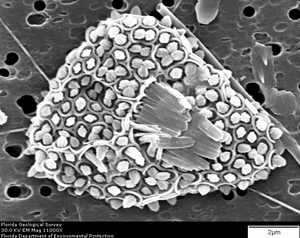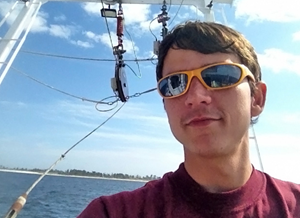
Deep-C_Cruz_MicroscopeIMG_0537-web-225×169.jpg” alt=”Jarrett Cruz examines nannoplankton samples under a microscope. (Photo provided by Jarrett Cruz)
Jarrett Cruz has been all over the world studying nannoplankton, a marine species he did not know existed when his journey began. Jarrett’s research into these minuscule creatures spans both biology and geology as he studies the impact of oil on nannoplankton that live in the Gulf of Mexico.
Jarrett, a geology Ph.D. student at Florida State University’s (FSU) Department of Earth, Ocean, and Atmospheric Science, is a GoMRI Scholar with the Deep-C consortium.
His Path
Jarrett took a high school career aptitude test, and the result of “scientist” surprised him. He laughed in disbelief, “I thought, ‘I’m never going to be a scientist!’” He enrolled as a criminology major at FSU, intending to become a police officer like his older brother but changed to biology after the first lab, which peaked his interest. He thought medical school would be his next step, and he continued that path since nothing else really appealed to him. However, things changed when Jarrett took a geology class taught by Dr. Sherwood Wise.

Jarrett separates nannoplankton from seawater samples. (Photo provided by Jarrett Cruz)
“The last semester of my bachelors I met Dr. Wise and began working for him in the Geology Department,” Jarrett explained. “He introduced me to nannofossils, nannoplankton, and the Deep-C project. I felt as though I finally found what I was looking for.”
He minored in geology, extending his biology undergraduate study to work more closely with Wise. Jarrett participated in five research expeditions on the R/V Bellows during that year and collected water and sediment samples for several Deep-C teams. The project’s focus on phytoplankton dovetailed perfectly with his biology background and his current study of nannofossils. He got such a good start on his research that he completed his master’s work in geology in just one year.
Jarrett recently returned from two months on the Indian Ocean, where he served as a nannofossil specialist with the Integrated Ocean Discovery Program, an international group that studies ocean floor geology, on the Drilling Vessel JOIDES Resolution. He used that experience to begin collecting data for his Ph.D.
His Work

A microscopic image of Navilithus altivelum, one of the species that Cruz studied. (Photo provided by Jarrett Cruz)
Jarrett has been recording the numbers and location of various nannoplankton species for five years. Nannoplankton can be found in all parts of the Gulf, but he focuses on those living in the photic zone, around 200 meters depth in the Gulf of Mexico. Very little baseline data exist for these populations, so the team is documenting seasonal variation and rare species as part of their research on oil impact and recovery of plankton. Jarrett said, “No one has ever done a quantitative study of nannoplankton through seasonal changes like this for the Gulf of Mexico.”
Nannoplankton are so small that they slip through standard plankton nets, so Jarrett extracted them from water and sediment samples. He filtered out anything larger than 50 microns using strainers. Then, using nucleopore filters, Jarrett isolated the nannoplankton and dried them while on board before transporting the collections to FSU for laboratory analysis.
Jarrett continued his work in the lab, cutting out sections of filters, attaching them to stubs using carbon tape, and then coating them with gold palladium. He observed his samples in a scanning electron microscope and counted the tiny disk-like plates (coccospheres) that nannoplankton shed. He made these counts by observing 200 different fields of view and identifying nannoplankton species encountered. Finally, he analyzed the resulting large data set to locate shifts in assemblages or species throughout the study interval.

One of the things Jarrett most enjoyed about his biology and geology work is time at sea. (Photo provided by Jarrett Cruz)
The team observed shifting numbers in diversity and abundances of nannoplankton cells from year-to-year. However, total increases in biomass and diversity seemed to show a recovery from the Deepwater Horizon spill over the four-year study interval.
While working on his nannoplankton survey, Jarrett made a remarkable discovery – finding Navilithus altivelum, a species only seen off the coast of Java in the Indian Ocean. “This find is particularly interesting because it brings to light how rare and diverse some of these oligotrophic species are,” said Jarrett.
His Learning
“There are questions in life you want to explore and answer,” Jarrett said. “That’s what research is, and it’s pretty amazing.”
Jarrett credits Wise and the Deep-C team with giving him the opportunity to answer questions and expand his abilities in other areas, particularly in speaking and writing. Saying that Wise is adamant that a good scientist must be a good communicator, Jarrett found himself regularly pushing his public speaking comfort zone. He worked as a teacher’s assistant and joined Wise at public outreach meetings and research conferences to present their findings. These events turned Jarrett from young man who had never flown on an airplane before college to an experienced world traveler, going to places such as Crete, Sri Lanka, and Singapore.
“My trip to Crete stood out because I presented my publication on a species observed in the Gulf that had never been spotted in the western hemisphere,” Jarrett said. “I actually got to hang out with the person who originally named the species, so that was a treat.”
His Future
Jarrett’s recent trip to India kick-started his Ph.D. research. He is also assisting with the publication of an Atlas of Coccolithphores and Diatoms in the Gulf of Mexico. The International Nannoplankton Association recently named him as an officer, which he called a great honor.
He plans to get industry experience this year, working with Bugware Incorporated on oil drilling operations. As an operations team member, Jarrett will look at the nannofossil assemblages to determine sediment age. His fossil analysis will help the drill operators choose the best equipment to get safely through sea floor.
Recently engaged, Jarrett plans to marry in the near future. After completing his Ph.D., he would like to stay in academia, perhaps continuing his research and teaching. He hopes to inspire others the way Wise inspired him.
Praise for Jarrett
Dr. Wise described Jarrett as a go-getter, full of energy and always on the move. According to him, Jarrett was a natural leader for the Deep-C project, “His undergraduate biology major was a perfect background for this work, which was a totally new experience for the rest of us with traditional geology degrees.”
Wise said that Jarrett’s transfer to study geology was seamless, “Jarrett is putting his GoMRI experience to good use toward his doctorate degree.”
The GoMRI community embraces bright and dedicated students like Jarrett Cruz and their important contributions. The GoMRI Scholars Program recognizes graduate students whose work focuses on GoMRI-funded projects and builds community for the next generation of ocean science professionals.
************
This research was made possible in part by a grant from BP/The Gulf of Mexico Research Initiative (GoMRI) to the Deepsea to Coast Connectivity in the Eastern Gulf of Mexico (Deep-C) consortium.
The GoMRI is a 10-year independent research program established to study the effect, and the potential associated impact, of hydrocarbon releases on the environment and public health, as well as to develop improved spill mitigation, oil detection, characterization and remediation technologies. An independent and academic 20-member Research Board makes the funding and research direction decisions to ensure the intellectual quality, effectiveness and academic independence of the GoMRI research. All research data, findings and publications will be made publicly available. The program was established through a $500 million financial commitment from BP. For more information, visit http://gulfresearchinitiative.org/.
